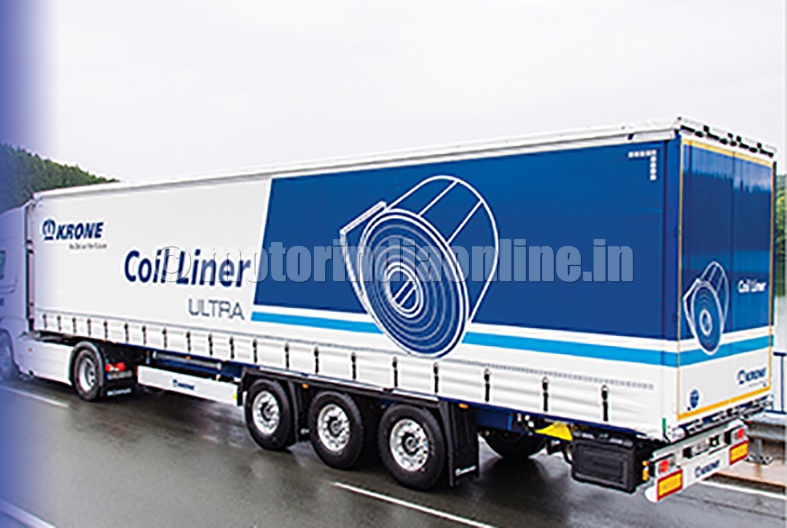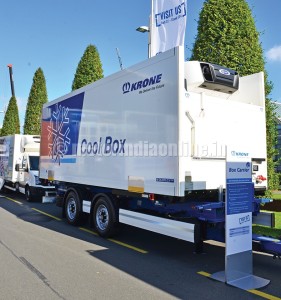“It is the best time to enter the Indian market:” says Mr. Wolfgang Wolke, Global Head (Product Design) at Fahrzeugwerk Bernard KRONE GmbH, Europe’s leading commercial vehicle trailer manufacturing company. The KRONE brand is synonymous with high quality semi-trailers and refrigerated trailers in Europe and is known for its high quality products around the world. “We have been discussing the various opportunities available for our range of trailers with various OEMs and customers in India over the past year and we are absolutely convinced that the market is ready for our products as there is a big supply gap, which we can bridge. We have identified the requirements of the market through a detailed study and have decided to partner with SATRAC Engineering, India’s reputed local trailer& truck body manufacturer”.
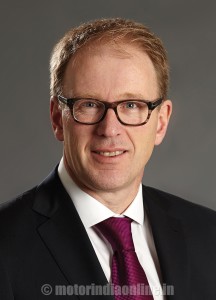
MOTORINDIA met Mr. Wolke, along with KRONE’s partners in India, Mr. M.C. Bantwal, Director, SATRAC Engineering, one of India’s leading trailer manufacturers and Mr. Anuj Sood, Managing Director, Droege Group (India) – KRONE’s advisors for its India entry endeavour.
KRONE is a family owned manufacturing concern operating in two main business verticals: agricultural machinery and automotive trailer. With an annual turnover of EUR 1.05 bn in the automotive trailer segment, KRONE is the second largest trailer manufacturing company in Europe with an annual production capacity of 50,000 semi-trailers, 10,000 swap bodies & super structures and 10,000 refrigerated trailers (reefers). Despite such strong references in Europe, Mr. Wolke believes that indigenous products would be required for the Indian market with certain modifications of the European trailer. However, the technology can be easily brought in by joining hands with the right partner, with the partnership would be capable of designing and manufacturing the most apt models for effective market penetration.
SATRAC is a well-known trailer & truck body manufacturer based in Bangalore, offering innovative solutions and are in this domain for over two decades. M.C. Bantwal has witnessed the changing dynamics of the commercial vehicle industry in India over the last 15 years and says: “In today’s context, Total Cost of Ownership (TCO) has become an important criterion and the market is likely to shift towards haulage products that provide high performance and reliability while lowering total costs over the lifetime of the vehicle”. SATRAC views this association with KRONE as a necessary step in bringing in higher quality, higher reliability and fuel-efficient products to the Indian Market.
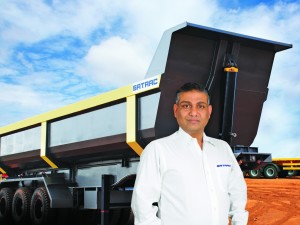
Anuj Sood, who heads the Indian operations of the EUR 8.2 bn German capital and advisory firm, Droege Group, says that Droege Group has focused on the manufacturing industry in India with a strong commitment to improve the quality of the “Made in India” products. Over the past year, Droege Group has undertaken a detailed market assessment of the India Commercial vehicle industry to identify business opportunities for KRONE in India, and has been instrumental in bringing KRONE and SATRAC together.
Models for the evolving market
The Indian trailer market size is between 18,000 to 20,000 units per annum and the market for overburden tippers is around 3,000 to 4,000 units per annum, with both markets expected to grow at a rate of 10-15% annually till 2020. The trailer market is highly unorganized and fragmented in nature with a large numbers of smaller players accounting for over 80% of the production. The organized sector has a handful of trailer manufacturers, fighting hard to gain acceptance for higher quality trailers. The overburden tipper segment has recently seen the advent of large global truck manufacturers who offer high performance tippers with heavy duty bodies.
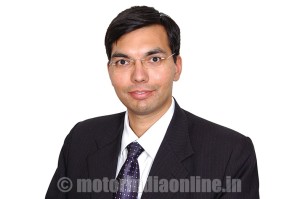
We ask Mr. Wolke as to how KRONE plans to position itself and its products to take on the competition.
Wolfgang Wolke: We have identified the first set of products for the Indian market. Working together with SATRAC, we will begin production of flatbed trailers, skeletal trailers and heavy duty tippers in the first phase, gradually introducing curtain-siders and reefer boxes (for rigid trucks) going forward. Currently, there is no market for reefer semi-trailers or swap bodies. The situation is no different from what prevailed in Europe 30 to 40 years ago. Over the years, the European market consolidated and we have a few large trailer manufacturers covering almost all markets with a few small players operating for customized applications. I believe the same will happen here with customers slowly shifting to high quality specialized solutions due to market dynamics, guided by various technical and regulatory factors. In the long run, the procurement decisions will invariably favour trailers offering higher standards, higher quality, reliability and better productivity. KRONE has seen the development of the trailer/ truck body market in Europe over the last decades, and has the requisite know-how and product portfolio for the Indian market in the mid-long term. And of course we would need a local partner to leverage the advantages and ensure success in the marketplace.
What are the USPs of KRONE trailers and how do they compare vis-à-vis competition?
Wolfgang Wolke: It varies based on each product; in the overall perspective, KRONE trailers & superstructures are sturdy offering the lowest maintenance and ownership costs which also results in fetching a higher resale costs compared to other makes at the end of the cycle after 6-8 years. Load security is another important feature in these trailers & truck bodies. In reefer solutions, KRONE provides good FRC insulation all over to minimise energy loss. Other important features include dynamic wheelbase control (DWC), air suspension, EBS, ABS, super single tyre, telematics, etc., to name a few. As for the local market, air suspension should be considered first for implementation along with EBS, ABS and followed soon by super single tyres 385/65 R 22.5. Special solutions like coil transportation can be considered in future. Also I would like to point out that in the absence of a cold chain system more than 30% losses occur in transportation and hence the alleviation of the same should be one of the key priority focus areas in the logistics domain.
What about the overall efficiency factor viz., the cross-effect in getting attached to the tractor and would that mean a close working association with vehicle OEMs?
Wolfgang Wolke: KRONE and SATRAC are both highly valued partners of key truck OEMs in Europe as well as India; we expect to work closely with them in the future in this market. However, in Europe, we see more and more of multimodal transport taking place and this means increasingly no tractor stays in front of the trailer, i.e., the trailers are becoming stand-alone units for most of the time. Hence our efforts are primarily on the trailer and to better its performance. Also I would like to add that the trend witnessed since early ‘90s in Europe is bound to happen in India. Earlier we had many small time fleet operators including owner-drivers and few big fleet owners meeting the market demands. However this has changed in the last two decades and today we find many big fleet operators having 6,000 to 18,000 trailers and both their numbers and as well as the fleet sizes are increasing. The number of small time operators has dramatically reduced and we expect this to happen gradually in India. More importantly the big fleet operators will invariably opt for quality trailers and truck bodies from big manufacturers and when this happens, KRONE is bound to perform well. Also, many global companies who entered the Indian market recently, like Wal-Mart, Tesco and IKEA, are bound to replicate their contemporary logistics model followed in other countries and this is likely to spell good news for the organised sector. The smaller players would not be able to meet the quality norms and other stringent demands of these companies. Also the impeding act allowing usage of multiple tractors for a trailer should also add momentum to the market. We see this demand in the short term and these factors have been considered in our association with SATRAC for addressing future market needs.”
Cooperation and approach
KRONE and SATRAC have signed an MoU recently to work together in the Indian market and expect the partnership to be set up by mid-2015.
M.C. Bantwal says: “Droege Group introduced KRONE to SATRAC and post several detailed discussions in both India and Germany, we have identified several areas for mutual co-operation and synergies that can be capitalized upon. SATRAC team has visited the KRONE manufacturing plant in Werlte, Germany to understand the level of manufacturing.
The visit to KRONE plant was really helpful and we want to take our manufacturing setup and processes to the next level for the evolving market – by taking KRONE’s assistance in advanced design, efficient manufacturing, superior finish and offer products with high performance and durability. Both companies have a similar mind-set on customer satisfaction and are quality focused which makes it easy for us to join hands for the Indian market.”
Adds Mr. Anuj Sood: “To be really successful in the Indian market, you have to invest and plan for the long term. KRONE understands this and is committed to deliver value to Indian customers. The current costs of logistics in India are extremely high due to multiple factors and introduction of KRONE’s products in the Indian market would go a long way in increasing efficiency in the sector. This is KRONE’s first foray in Asia and is an important development for the company to expand its global footprint. KRONE has also identified further synergies in the Indian market and is currently viewing India as a sourcing destination, for both technical services and components.”
Challenges and trends
How does the consortium plan to address the challenges like the lack of good infrastructure, competition, prevailing complex tax structure, overloading and the popularity of rigid chassis?
Wolfgang Wolke: Our trailers operate in much more challenging conditions than that prevailing here, over 5,000 trailers from Europe routinely carried various supplies for the armed forces in Afghanistan. That’s where our product strength and reliability come into play. Once the GST is implemented and the axle overloading regulation becomes effective, companies will opt for lighter and stronger chassis and our products would be sought after. SATRAC is already manufacturing high quality products like trailers and half tube tippers made with high strength steel from SSAB and this platform can be used to launch further models like the curtain-sider with special curtain fabric replacing the steel container side walls that are lighter; resulting in higher payloads and lower loading/ unloading times. Trailer is essentially a commoditized product; customers need to be offered tailor made solutions with lighter materials, telematics, payload optimization, etc. to really stand out as a leader in this market
M.C. Bantwal: India is the world’s biggest market for rigid chassis trucks in the GVW range 16 to 31 ton currently. With the implementation of the above mentioned factors, the hub and spoke model of logistics would come into play and there will be migration from rigid trucks into truck trailer combinations. In the overburden tipper segment, we see a shift towards lighter high performance new generation tippers.
Anuj Sood: The key levers that should drive the market factors include introduction of trailer code, implementation of GST, growth of the retail segment, food security bill and reduction of wastage.
Mr. Wolke summarizes: “KRONE is convinced about the market and evolving expectations of the customer vis-à-vis high quality standards and reliability; and that’s what the combine’s equation providing through their offering. When the innovative and customer focussed manufacturers join hands to take the product experience to a new level, the ultimate beneficiaries are going to be the customers; and against such progressive developments, the new generation trailers, tippers & truck bodies should definitely be increasingly looked at as one of the important links for productivity booster in the transport chain – their time indeed has arrived.
